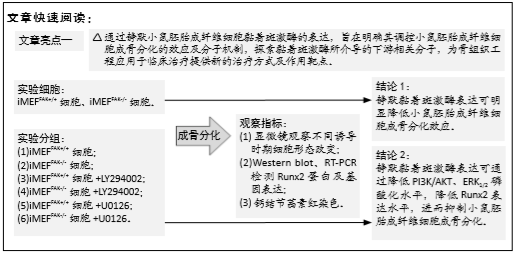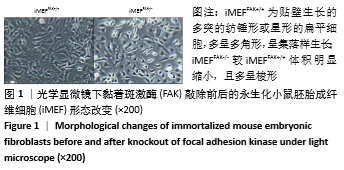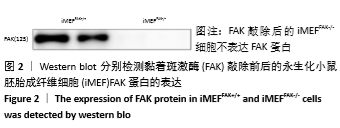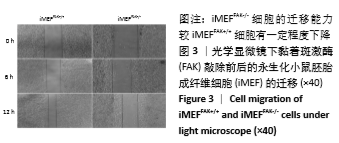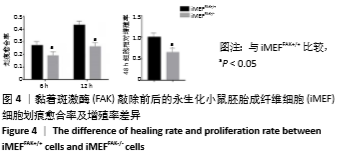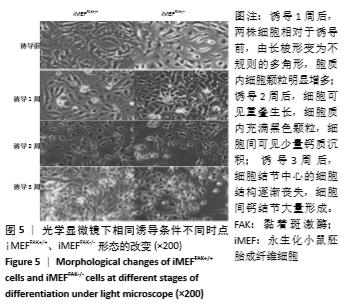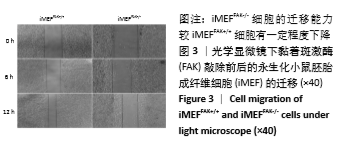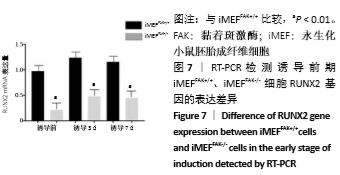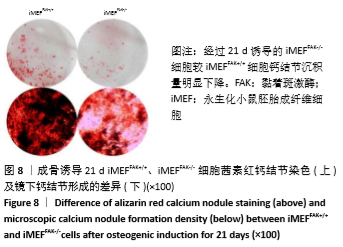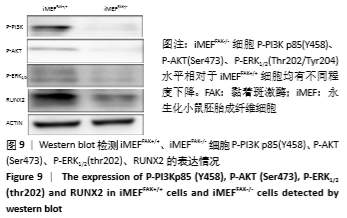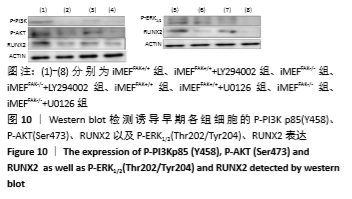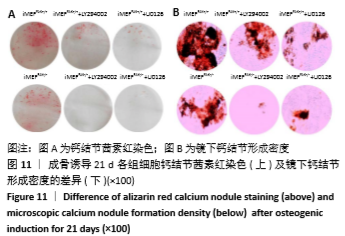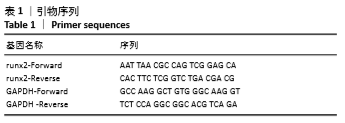[1] 马远征,王以朋,刘强,等.中国老年骨质疏松症诊疗指南(2018)[J]. 中国实用内科杂志,2019,39(1):38-61.
[2] 鲁先闯, 张志峰,黄健. 骨髓间充质干细胞修复软骨缺损的应用前景[J]. 中国组织工程研究, 2015,19(19):3093-3088.
[3] CAPLAN AI. Mesenchymal Stem Cells: Time to Change the Name! Stem Cells Transl Med. 2017;6(6):1445-1451.
[4] ZAJDEL A, KALUCKA M, KOKOSZKA-MIKOLAJ E, et al. Osteogenic differentiation of human mesenchymal stem cells from adipose tissue and Wharton’s jelly of the umbilical cord. Acta Biochim Pol. 2017; 64(2):365-369.
[5] ARTHUR A, ZANNETTINO A, GRONTHOS S. The therapeutic applications of multipotential mesenchymal/stromal stem cells in skeletal tissue repair. J Cell Physiol. 2009;218(2):237-245.
[6] HUANG E, BI Y, JIANG W, et al. Conditionally immortalized mouse embryonic fibroblasts retain proliferative activity without compromising multipotent differentiation potential. PLoS One. 2012; 7(2):e32428.
[7] Nelson FR, Brighton CT, Ryaby J, et al. Use of physical forces in bone healing. J Am Acad Orthop Surg. 2003; 11(5):344-354.
[8] 廉静. Notch信号通路在BMP2诱导iMEF细胞成骨分化中的作用及机制研究[D]. 重庆:重庆医科大学,2016.
[9] KOMORI T. Regulation of proliferation, differentiation and functions of osteoblasts by Runx2. Int J Mol Sci. 2019;20(7):1694.
[10] KOMORI T. Molecular mechanism of runx2-dependent bone development. Mol Cells. 2020;43(2):168-175.
[11] 陈力莹,范锟铻,王金水,等. Wnt-1基因对人表皮干细胞的分化与增殖的影响研究[J]. 中华损伤与修复杂志,2012,7(1):29-33.
[12] 施彦,舒斌,杨荣华,等. Wnt和Notch信号通路在大鼠创面愈合模型中的表达作用[J].中华损伤与修复杂志,2014,9(2):31-34.
[13] GU H, HUANG Z, YIN X, et al. Role of c-Jun N-terminal kinase in the osteogenic and adipogenic differentiation of human adipose-derived mesenchymal stem cells. Exp Cell Res. 2015; 339(1):112-121.
[14] KAMAMOTO M, MACHIDA J, MIYACHI H, et al. A novel mutation in the C-terminal region of RUNX2/CBFA1 distal to the DNA-binding runt domain in a Japanese patient with cleidocranial dysplasia. Int J Oral Maxillofac Surg. 2011; 40(4):434-437.
[15] FRANCESCHI RT, XIAO G. Regulation of the osteoblast-specific transcription factor, Runx2: responsiveness to multiple signal transduction pathways. J Cell Biochem. 2003; 88(3):446-454.
[16] SCHLAEPFER DD, HAUCK CR, SIEG DJ. Signaling through focal adhesion kinase. Prog Biophys Mol Biol. 1999;71(3-4):435-478.
[17] ZHAO X, GUAN JL. Focal adhesion kinase and its signaling pathways in cell migration and angiogenesis. Adv Drug Deliv Rev. 2011;63(8): 610-615.
[18] MITRA SK, SCHLAEPFER DD. Integrin-regulated FAK-Src signaling in normal and cancer cells. Curr Opin Cell Biol. 2006; 18(5):516-523.
[19] ZACHARY I, ROZENGURT E. Focal adhesion kinase (p125FAK): a point of convergence in the action of neuropeptides, integrins, and oncogenes. Cell. 1992;71(6):891-894.
[20] HAKUNO D, TAKAHASHI T, LAMMERDING J, et al. Focal adhesion kinase signaling regulates cardiogenesis of embryonic stem cells. J Biol Chem. 2005;280(47):39534-39544.
[21] SHEN TL, PARK AY, ALCARAZ A, et al. Conditional knockout of focal adhesion kinase in endothelial cells reveals its role in angiogenesis and vascular development in late embryogenesis. J Cell Biol. 2005; 169(6):941-952.
[22] SUN X, ZHENG W, QIAN C, et al. Focal adhesion kinase promotes BMP2-induced osteogenic differentiation of human urinary stem cells via AMPK and Wnt signaling pathways. J Cell Physiol. 2020;235(5): 4954-4964.
[23] FURUTA Y, ILIC D, KANAZAWA S, et al. Mesodermal defect in late phase of gastrulation by a targeted mutation of focal adhesion kinase, FAK. Oncogene. 1995;11(10):1989-1995.
[24] ILIC D, FURUTA Y, KANAZAWA S, et al. Reduced cell motility and enhanced focal adhesion contact formation in cells from FAK-deficient mice. Nature.1995; 377(6549):539-544.
[25] WANG J, XIANG B, DENG J, et al. Inhibition of viability, proliferation, cytokines secretion, surface antigen expression, and adipogenic and osteogenic differentiation of adipose-derived stem cells by seven-day exposure to 0.5 t static magnetic fields. Stem Cells Int. 2016; 2016:7168175.
[26] 胡新永,吕原,杨华清,等.糖皮质激素对膝关节周围成骨细胞一氧化氮合酶和骨重建的影响[J].中华损伤与修复杂志,2008, 3(4):439-444.
[27] HSU LW, GOTO S, NAKANO T, et al. The effect of exogenous histone H1 on rat adipose-derived stem cell proliferation, migration, and osteogenic differentiation in vitro. J Cell Physiol. 2012;227(10): 3417-3425.
[28] HU P, ZHU X, ZHAO C, et al. Fak silencing impairs osteogenic differentiation of bone mesenchymal stem cells induced by uniaxial mechanical stretch. J Dent Sci.2019;14(3):225-233.
[29] HU J, LIAO H, MA Z, et al. Focal adhesion kinase signaling mediated the enhancement of osteogenesis of human mesenchymal stem cells induced by extracorporeal shockwave. Sci Rep.2016; 6:20875.
[30] 扎拉嘎胡,徐忠伟,兰晓霞,等. 层粘连蛋白促脐带间充质干细胞向成骨细胞分化与黏着斑激酶表达[J]. 中国组织工程研究,2011, 15(6):29-33.
[31] XIE H, CAO T, FRANCO-OBREGON A, et al. Graphene-Induced Osteogenic Differentiation Is Mediated by the Integrin/FAK Axis. Int J Mol Sci. 2019;20(3):574.
[32] YUAN C, GOU X, DENG J, et al. FAK and BMP-9 synergistically trigger osteogenic differentiation and bone formation of adipose derived stem cells through enhancing Wnt-beta-catenin signaling. Biomed Pharmacother. 2018; 105:753-757.
[33] WU J, ZHAO J, SUN L, et al. Long non-coding RNA H19 mediates mechanical tension-induced osteogenesis of bone marrow mesenchymal stem cells via FAK by sponging miR-138. Bone. 2018;108: 62-70.
[34] LIU Y, MA Y, ZHANG J, et al. MBG-Modified beta-TCP Scaffold Promotes Mesenchymal Stem Cells Adhesion and Osteogenic Differentiation via a FAK/MAPK Signaling Pathway. ACS Appl Mater Interfaces. 2017; 9(36):30283-30296.
[35] THORPE LM, YUZUGULLU H, ZHAO JJ. PI3K in cancer: divergent roles of isoforms, modes of activation and therapeutic targeting. Nat Rev Cancer. 2015; 15(1):7-24.
[36] YU JS, CUI W. Proliferation, survival and metabolism: the role of PI3K/AKT/mTOR signalling in pluripotency and cell fate determination. Development. 2016;143(17):3050-3060.
[37] GU YX, DU J, SI MS, et al. The roles of PI3K/Akt signaling pathway in regulating MC3T3-E1 preosteoblast proliferation and differentiation on SLA and SLActive titanium surfaces. J Biomed Mater Res A. 2013; 101(3):748-754.
[38] CHEN LL, HUANG M, TAN JY, et al. PI3K/AKT pathway involvement in the osteogenic effects of osteoclast culture supernatants on preosteoblast cells. Tissue Eng Part A. 2013;19(19-20):2226-2232.
[39] ZHANG Y, YANG JH. Activation of the PI3K/Akt pathway by oxidative stress mediates high glucose-induced increase of adipogenic differentiation in primary rat osteoblasts. J Cell Biochem. 2013;114(11): 2595-2602.
[40] GARTY J, KAUPPI M, KAUPPI A. Differential responses of certain lichen species to sulfur-containing solutions under acidic conditions as expressed by the production of stress-ethylene. Environ Res. 1995; 69(2):132-143.
[41] TWIGG SR, VORGIA E, MCGOWAN SJ, et al. Reduced dosage of ERF causes complex craniosynostosis in humans and mice and links ERK1/2 signaling to regulation of osteogenesis. Nat Genet. 2013; 45(3): 308-313.
[42] BAI B, HE J, LI YS, et al. Activation of the ERK1/2 signaling pathway during the osteogenic differentiation of mesenchymal stem cells cultured on substrates modified with various chemical groups. Biomed Res Int. 2013;2013:361906.
[43] XU L, MENG F, NI M, et al. N-cadherin regulates osteogenesis and migration of bone marrow-derived mesenchymal stem cells. Mol Biol Rep. 2013;40(3):2533-2539.
[44] MIRAOUI H, OUDINA K, PETITE H, et al. Fibroblast growth factor receptor 2 promotes osteogenic differentiation in mesenchymal cells via ERK1/2 and protein kinase C signaling. J Biol Chem. 2009; 284(8):4897-4904.
|
